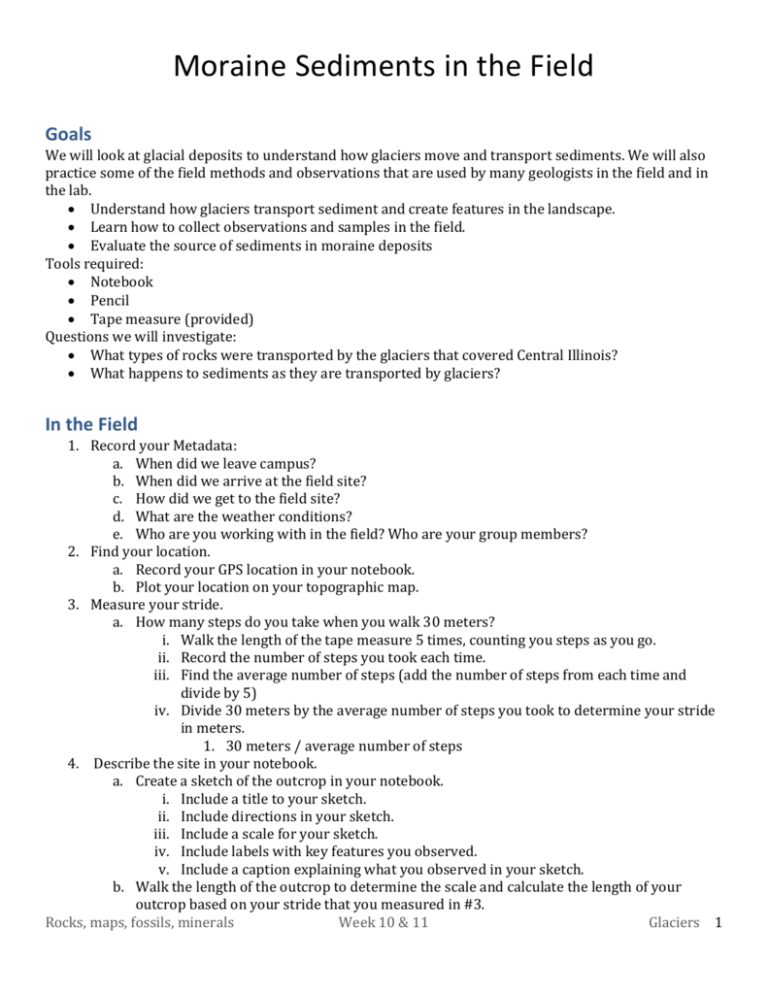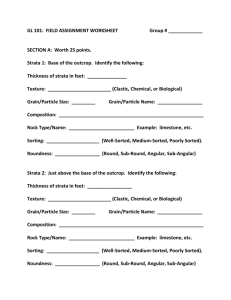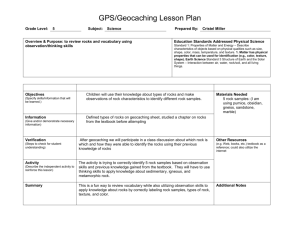Moraine Deposits Field Activity
advertisement

Moraine Sediments in the Field Goals We will look at glacial deposits to understand how glaciers move and transport sediments. We will also practice some of the field methods and observations that are used by many geologists in the field and in the lab. Understand how glaciers transport sediment and create features in the landscape. Learn how to collect observations and samples in the field. Evaluate the source of sediments in moraine deposits Tools required: Notebook Pencil Tape measure (provided) Questions we will investigate: What types of rocks were transported by the glaciers that covered Central Illinois? What happens to sediments as they are transported by glaciers? In the Field 1. Record your Metadata: a. When did we leave campus? b. When did we arrive at the field site? c. How did we get to the field site? d. What are the weather conditions? e. Who are you working with in the field? Who are your group members? 2. Find your location. a. Record your GPS location in your notebook. b. Plot your location on your topographic map. 3. Measure your stride. a. How many steps do you take when you walk 30 meters? i. Walk the length of the tape measure 5 times, counting you steps as you go. ii. Record the number of steps you took each time. iii. Find the average number of steps (add the number of steps from each time and divide by 5) iv. Divide 30 meters by the average number of steps you took to determine your stride in meters. 1. 30 meters / average number of steps 4. Describe the site in your notebook. a. Create a sketch of the outcrop in your notebook. i. Include a title to your sketch. ii. Include directions in your sketch. iii. Include a scale for your sketch. iv. Include labels with key features you observed. v. Include a caption explaining what you observed in your sketch. b. Walk the length of the outcrop to determine the scale and calculate the length of your outcrop based on your stride that you measured in #3. Rocks, maps, fossils, minerals Week 10 & 11 Glaciers 1 c. Using the scale on your topographic map and the distance along the outcrop, mark the outcrop on your map as a line. Remember it should be to scale. How long is the line in map units? 5. Collect surface gravels and cobbles. a. In your groups, find an area on the outcrop to work. b. Locate an area 1 meter by 1 meter. i. Draw a sketch of your area as a representative 1m x 1m square in your notebook. The purpose of this sketch is to show the sizes of sediment represented in your area where you will be collecting your sample. It should act like a photo in case you have questions on how the site looked before you collected the sample. c. Collect 50 gravel or cobble sized rocks from the square surface area of the outcrop and place them in your sample bag. d. Label your sample bag with the names of your group members and the letters CMS for Comlara Moraine Surface. 6. In your notebook, summarize the methods that you used above. You should also include observations about the sediments that you collected and about the surface of the outcrop. Also include notes about challenges collecting your sample, for example, were there any plants or roots that influenced where and how deep you were able to collect your sample or did you have problems with material from the surface falling into the area that you were digging into for your sample? a. What tools did you use? b. How thick were the rocks on the surface? c. Did you randomly select the cobbles from the surface or did you collect them systematically across your 1m x 1m area? d. How long did it take you to collect each sample? 7. Make sure your bags are closed and you pack all the equipment in the van before leaving the field. Note the time you left the field in your notebook. In the Lab 8. With your partners, study the 50 gravel and cobble samples that you collected. a. What is the type of rock for each gravel or cobble? b. What is the intermediate length of each gravel or cobble? i. You can make these measurements with the calipers provided. c. Observe the roundness of each gravel or cobble. Use Figure 1 to assign a numeric value to the roundness of each gravel or cobble. d. Record your observations in your notebook in a table similar to the one shown below. Don’t forget to include uncertainty. Rock # Rock Type Intermediate Roundness length 1 2 3 9. Create a chart showing the number of each type of rock you observed in your gravels and cobbles. a. The rock type categories should be on the x-axis and the count should be on the y-axis. Rocks, maps, fossils, minerals Week 10 & 11 Glaciers 2 10. Calculate the average intermediate length and standard deviation for each rock type and summarize your values in a table. 11. Summarize the roundness for each rock type. Calculate the average roundness and standard deviation for each rock type. 12. Create a chart showing the distribution of rock types from the maps that we downloaded and viewed last week in ArcMap. The table summarizing your results is posted on Reggienet. 13. Compare the charts of mapped bedrock units to the histogram of observed rock types from Comlara. a. Based on the mapped distribution of bedrock types, which rock type would you expect to see the most of in glacial deposits? b. Did your observations from the field match your prediction? Why or why not? What to turn in: 14. Turn in the following items (5 points each): a. From field and field samples i. Field map with outcrop location ii. Table with 50 rock observations, roundness, intermediate lengths 1. average roundness and standard deviations 2. average intermediate lengths and standard deviations. iii. % rock type chart b. From computer lab: i. Table with map bedrock distributions ii. Map with bedrock distributions for 4 states iii. % area bedrock chart 15. Answer the following questions (5 points each): a. Based on the mapped distribution of bedrock types, which rock type would you expect to see the most of in glacial deposits? b. What was the most common rock type in the maps? c. What was the most common rock type observed in the field d. What type of rocks were the most rounded? What type of rocks were the least rounded? e. What types of rocks were the largest? What types of rocks were the smallest? f. Did your observations of rock types from the field match your map prediction? Why or why not? g. Explain how glaciers pick up, move and break apart rocks. h. Why might some types of rocks be easier to round and break into smaller pieces than others? i. How does the distance that the rocks travel influence the size of the different rock types in the moraine deposits? Rocks, maps, fossils, minerals Week 10 & 11 Glaciers 3 Figure 1. Krumbein Roundness. Use this chart to assign a roundness value to each gravel and cobble that you observe. Rocks, maps, fossils, minerals Week 10 & 11 Glaciers 4







